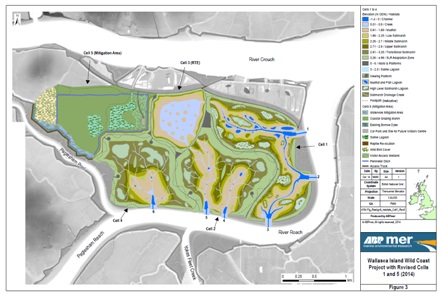Creating a technical advisory panel for sound planning
Plan of currently consents scheme – developed with input from the TAP
RSPB, 2015
The project answers to a technical advisory panel (TAP), which meets every six months. This is comprised of a wide range of relevant stakeholders, both directly and indirectly affected by the project. Relevant parties include: Natural England, the Environment Agency (four or five individuals representing each of various arms of the EA that are involved – the environmental permitting team, the land drainage consent team, and the seawall maintenance team), the Crouch Harbour Authority, the local planning authority, Defra, the Essex County Council authorities, the Rochford District Council’s head of planning, Crossrail representatives, the RSPB, individuals from the Centre for Environment, Fisheries, and Aquacultural Sciences (local fisheries advisors), and the Wallasea Island landowner (Wallasea Farms Inc). This panel was a critical source of expertise and analysis during early implementation, and continues to provide advice as the project is completed on potential barriers and means to overcome these.
The existence of the TAP provided an underlying sense of confidence in the planning and implementation process, in order to deal with foreseen barriers. The panel supported extensive modelling, environmental impact assessments, and redesign of solutions. In particular, the design of three smaller managed realignments rather than one large one helped to overcome the problem of scale which was faced in the project.
In a project with such a high chance of technical barriers as in Wallasea Island, a technical advisory panel can be instrumental in a smooth and successful planning and implementation process. The function is essentially to support the identification of both technical and regulatory barriers and development of means to overcome these prior to project implementation.
